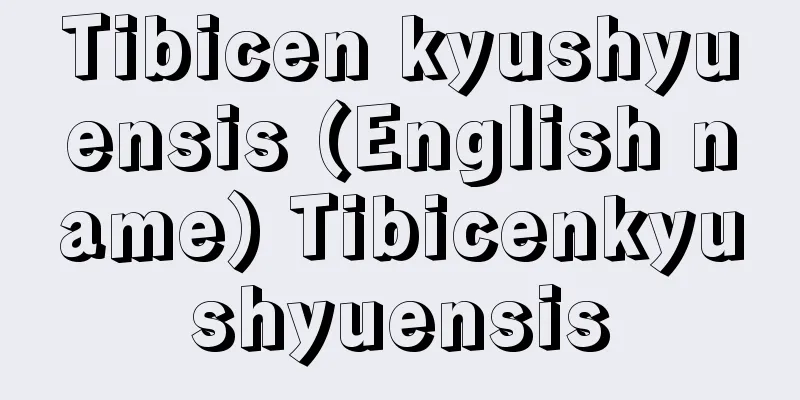Posthumous name - Okurina

|
In ancient China and Japan, it was a name given to people of high social standing after death, and is said to have originated in the Zhou dynasty. It is also called a posthumous name. [Miyazaki City] ChinaIn the homes of kings, nobles, and aristocrats, descendants would build ancestral shrines for their ancestors, appoint a Buddhist priest there, and enshrine him with his posthumous name written on it, similar to the way Buddhists enshrine memorial tablets with posthumous names written on them. Appropriate characters for the posthumous name are chosen based on the deeds the person performed during their lifetime. At the beginning of the Records of the Grand Historian (Zhengyi), there is an explanation of posthumous names by Zhang Shouje of the Tang dynasty, according to which King Wen, King Wu, and King Cheng were beautiful names given to kings with high virtue, while King You and King Ling were ugly names given to kings with less virtue, and King Ping and King Zhuang were somewhere in between. In the case of feudal lords, they were given titles according to their respective ranks, such as Duke Huan and Hou Wu. In later generations, the posthumous titles for ministers were highest for Duke Wen, followed by Duke Wen Zheng. The First Emperor of Qin, claiming that posthumous names were an excess of authority because they were decided by a king's subjects after his death, based on their degree of virtue, he abolished the system of posthumous names and ordered that, since he was the first, he should be called the First Emperor, and thereafter the Second Emperor, the Third Emperor, and so on, in order of descent, to be passed down for all generations. However, in the Han dynasty, the posthumous name system was revived, and throughout history, from the Northern and Southern Dynasties through to the Sui dynasty, many emperors were called by their posthumous names. The only exception was Emperor Gaozu of the Han dynasty, whose temple name was Taizu and whose posthumous name was Emperor Gao. However, the way he was called, rather than either of these, probably followed the common name used in the Han dynasty. After the Tang Dynasty, it became common to refer to emperors by temple names, such as Gaozu and Taizong. This was because the number of characters in posthumous names increased; Gaozu was the Great Sage, Great Guangxiao Emperor, while Suzong was the Great Sage, Great Xuanxiao Emperor, with the number of names gradually increasing, and it became impossible to refer to them all by their posthumous names. During the Han Dynasty, each emperor was not necessarily able to monopolize his own temple, and the principle was that the temple was passed on to his descendants in sequence, and only emperors with particularly great achievements were allowed to keep their personal temples unchanged. However, in later generations, each emperor who reigned was able to build his own temple, and there was no emperor without a temple name, so it became possible to refer to emperors by their temple names instead of posthumous names. This trend had already begun in the Northern Wei dynasty - Emperor Xiaowen was also referred to by his temple name Gaozu - but it became common during the Tang dynasty and continued into the Song dynasty. In the Ming dynasty, a new trend in how emperors were referred to emerged, and that was to refer to them by the era name. The posthumous name of the Ming emperor Taizu was 21 characters long, and some refer to him by just the last character, Gao Emperor, but this is merely an abbreviation. However, there have been so many temple names for Emperor Taizu throughout history that there is a risk of confusion. However, since the Ming dynasty began the one-emperor, one-yuan system, it was most convenient to refer to him by the era name, such as Hongwu Emperor, and this was commonly used throughout the Ming and Qing dynasties, but this was not the official title. [Miyazaki City] JapanIn Japan, the first type is the posthumous name of successive emperors, and the second type is the posthumous name of subjects (nobles, high-ranking officials, samurai, scholars, and monks). In the olden days, the first type was called "Emperor of such and such a palace," but when the Imperial Palace was settled, for example Emperor Mommu was called Emperor Amanomamune Toyojino Sumeramikoto, and this was called a Japanese-style posthumous name. However, after Emperor Kanmu moved the capital to Heian-kyo, Chinese-style posthumous names were used, and it is said that he had Oumi no Mifune select the posthumous names of successive emperors. These were the posthumous names used from Emperor Jinmu to Emperor Konin. However, there are differing theories regarding this selection. After Kanmu, there were few Chinese-style posthumous names; most were names that used the name of the imperial palace directly, names of imperial tombs, or names with the character "later" added to the title of the previous emperor. The three emperors of Meiji, Taisho, and Showa were new examples of posthumous names based on era names. In the second category, that is, among subjects, (1) there were cases where posthumous titles were given to those who became Daijo-daijin (Fujiwara no Fuhito's Bunchu-ko), but those who became Buddhist monks did not have posthumous titles. (2) Among the warrior classes, certain feudal lords in the Edo period (such as Tokugawa Yoshinao's Takako of Owari, Tokugawa Yorifusa's Ikko, Mitsukuni's Yoshiko, and Nariaki's Retsu-ko) were given posthumous titles. (3) Among scholars, not only Confucian scholars (such as Hayashi Razan's Bunbin and Kinoshita Junan's Kyosei) were given posthumous titles in the Chinese style, but also scholars of Japanese classics (such as Motoori Norinaga's Akitsuhiko Mitsumune Sakurane no Oshi). (4) It has been customary for monks to be given posthumous titles since ancient times, with the title Daishi (Dengyo Daishi by Saicho, Kobo Daishi by Kukai, etc.) being the most important title. In addition, there were other titles such as Bosatsu, Kokushi, Zenshi, Osho, and Shonin, and Zenshi, Osho, and Shonin were allowed to use private titles. [Shinji Ono] Source: Shogakukan Encyclopedia Nipponica About Encyclopedia Nipponica Information | Legend |
|
旧中国や日本などにおいて身分ある人に死後贈られた名で、周代に始まるといわれる。諡号(しごう)ともいう。 [宮崎市定] 中国王公貴族の家では、子孫が祖先のために宗廟(そうびょう)を設け、その中に木主(ぼくしゅ)を立て諡を書いて祀(まつ)ることは、仏教において法号を書いた位牌(いはい)を祀るごときものであった。諡にはその人の生前の行為により適当な文字を選ぶ。『史記正義』の首に唐の張守節の諡法解(しほうかい)を載せているが、それによると、文王、武王、成王などは徳の高い王者に贈られる美名であり、幽王、霊王などは徳の劣った王に対する醜名であって、平王、荘王などはその中間に位する。諸侯の場合は桓公(かんこう)、武侯のようにそれぞれの爵に従う。後世、大臣の諡は文公を最高とし、文正公がこれに次いだ。秦(しん)の始皇帝は、諡とは王者の死後に臣下が徳の高下を評議して定めるのであるから越権であるとし、諡の制を廃し、自身は最初であるから始皇帝、以後は二世皇帝、三世皇帝と代数でよんで万世まで伝えよと命じた。 しかし漢代になると、諡の制が復活し、以後南北朝を経て隋(ずい)代に至るまで、歴史上、天子の名は多く諡でよばれる。ただ漢の高祖だけは特別で、この場合廟号は太祖、諡は高皇帝なのであるが、そのいずれでもない高祖のよび方は、おそらく漢代の通称に従ったものであろう。 唐代以後、天子を高祖、太宗のように廟号でよぶことが普通となった。それは諡の文字が増してきたからで、高祖は神堯(しんぎょう)大聖大光孝皇帝であるが、粛宗(しゅくそう)は文明武徳大聖大宣孝皇帝と、しだいに増加して、いちいち諡号ではよびきれなくなったのである。漢代には各天子がそれぞれ固有の廟を独占するとは限らず、順次にその廟を子孫に譲るのが原則で、とくに功業の偉大な天子だけが、特別に個人の廟を守って変わらないことを認められた。しかるに後世、在位した天子はいずれも固有の廟を建てられ、廟号をもたない天子がないようになり、諡号のかわりに廟号をもって天子をよぶことが可能となったのである。この傾向はすでに北魏(ほくぎ)に始まっており、孝文帝はまた廟号の高祖でもよばれるが、唐に至って一般化し、宋(そう)まで続いた。 明(みん)に至って天子の呼び方に新しい傾向が生まれるが、それは年号による称(とな)え方である。明の太祖の諡号は実に21字に上るが、その最後の1字だけをとり高皇帝とよぶ称え方もあるが、これはあくまでも略称である。しかし、太祖という廟号は歴史上あまりに多すぎて混同されるおそれがある。ところが明(みん)から一世一元の制が始まったので、年号をとって洪武(こうぶ)帝というようによぶのがもっとも便利なため、明・清(しん)を通じて慣用されたが、ただしこれは正式の呼称ではない。 [宮崎市定] 日本日本では、第一には代々の天皇の諡、第二には人臣(公卿(くぎょう)高官、武家、学者、僧侶(そうりょ))の諡がある。まず第一のほうは、古くは「何々宮の御宇(ぎょう)天皇」といったが、皇居が一定するころになると、たとえば文武(もんむ)天皇を天之真宗豊祖父天皇(あまのまむねとよおおじのすめらみこと)と称した類があり、これを和風諡号といった。しかし桓武(かんむ)天皇が平安京に遷都後は漢風諡号を用いることとなり、淡海三船(おうみのみふね)をして歴代天皇の諡を選ばしめたという。神武(じんむ)から光仁(こうにん)天皇までの諡号がこれである。ただしこの選定に関しては異説がある。桓武以後には漢風の諡号は少なく、御所の名をそのまま使ったもの、山陵の名を用いたもの、前帝号に後の字を加えたものなどが多く、明治・大正・昭和の3天皇は年号を諡号とした新例である。 第二のほう、すなわち人臣では、(1)太政(だいじょう)大臣になった人に諡号を賜ったのが例(藤原不比等(ふひと)の文忠公など)であるが、入道した人には諡はない。(2)武家では江戸時代には特定の大名(尾張(おわり)の徳川義直(よしなお)の敬公、水戸の徳川頼房(よりふさ)の威公、同光圀(みつくに)の義公、同斉昭(なりあき)の烈公など)に、(3)学者では儒者(林羅山(らざん)の文敏、木下順庵(じゅんあん)の恭靖(きょうせい)など)の漢風はいうまでもないが、国学者(本居宣長(もとおりのりなが)の秋津彦美豆桜根大人(あきつひこみつさくらねのうし)など)にも和風の諡があった。(4)僧侶として諡を賜ったのは古くからあり、大師号(最澄(さいちょう)の伝教(でんぎょう)大師、空海(くうかい)の弘法(こうぼう)大師など)はもっとも重いものであった。そのほか、菩薩(ぼさつ)号、国師号、禅師号、和尚(おしょう)号、上人(しょうにん)号などもあり、禅師、和尚、上人は私称も許されていた。 [小野信二] 出典 小学館 日本大百科全書(ニッポニカ)日本大百科全書(ニッポニカ)について 情報 | 凡例 |
Recommend
Skovoroda, G.
...Ukraine became part of Russia in the 17th cent...
suspension structure
…In contrast, cables are weak in compression but ...
Men's Society - Danshikessha
A society that only men are allowed to join. It i...
Battle of Jutland
A naval battle between Germany and Britain that t...
Authority - authority
The word authority is commonly used in various se...
Republic of Nauru (English spelling) Republic of Nauru
…Official name: Republic of NauruArea: 21 km2Popu...
Rewinding
…(1) Rewinding is the process of winding raw silk...
Kirishima ebine - Kirishima ebine
An evergreen perennial plant of the orchid family...
Kanayama
〘noun〙① A mountain from which gold, silver, etc. a...
Wakutama Pond
A spring (special natural monument) located in the...
Milon base - Milon Enki
Chemical formula: Hg 2 N(OH)・2H 2 O. When yellow m...
Leaf mining moth
An insect of the Lepidoptera, Lyonetiidae family. ...
Shigeya Ohara - Ohara Jusai
1836-1902 A samurai and bureaucrat from the end o...
《Pather Panchali》(English spelling)
...Satyajit Ray, who organized the first cinema c...
Father-in-law/mother-in-law - Father-in-law and mother-in-law
Among the new kinship relationships established up...









